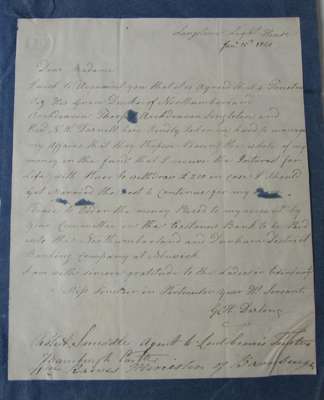
Lot 107

Longstone Lighthouse, Farne Islands, Northumberland - Darling, Grace


Rare Books, Maps and Manuscripts
Auction: 2 May 2012 at 12:00 BST
Description
Autograph letter signed from Grace Darling, discussing the Trust set up for the money raised for her after her audacious rescue of survivors from the wreck of Forfarshire "4 trustees viz His Grace Duke of Northumberland, Archdeacon Thorp ... have kindly taken in hand to manage my affairs, that they propose placing the whole of my money in the fund, that I receive the interest for life with power to withdraw £200 in case I should get married" and expressing gratitude for the contributions: "I am with sincere gratitude to the ladies in Edinburgh & Miss Sinclair in particular.", Longstone Light House, Jan. 10th 1840, one leaf
Footnote
Note: Grace Darling (1815–42) was a Victorian heroine who in 1838 saved 13 people from the wreck of the SS Forfarshire. In the early hours of 7 September 1838, Grace, looking from an upstairs window of the Longstone Lighthouse on the Farne Islands, spotted the wreck and survivors of the Forfarshire on Big Harcar, a nearby low rocky island. The Forfarshire had foundered on the rocks and broken in half: one of the halves had sunk during the night. She and her father determined that the weather was too rough for the lifeboat to put out from Seahouses, so they set out in a rowing boat and rowed virtually a mile to reach the survivors. Grace kept the boat steady in the water while her father helped four men and the lone surviving woman, Mrs. Dawson, into the boat. Although she survived the sinking, Mrs Dawson had lost her two young children during the night. William and three of the rescued men then rowed the boat back to the lighthouse. Grace then remained at the lighthouse while William and three of the rescued crew members rowed back and recovered the remaining survivors. Grace’s achievement was celebrated in her lifetime: she received a large financial reward in addition to the plaudits of the nation. A number of fictionalized depictions propagated the Grace Darling legend, such as Grace Darling, or the Maid of the Isles by Jerrold Vernon (1839), which gave birth to the legend of “the girl with windswept hair”. Her deed was committed to verse by William Wordsworth in his poem Grace Darling (1843). She died of tuberculosis in 1842, aged 26. Manuscripts by Grace Darling are rare.

